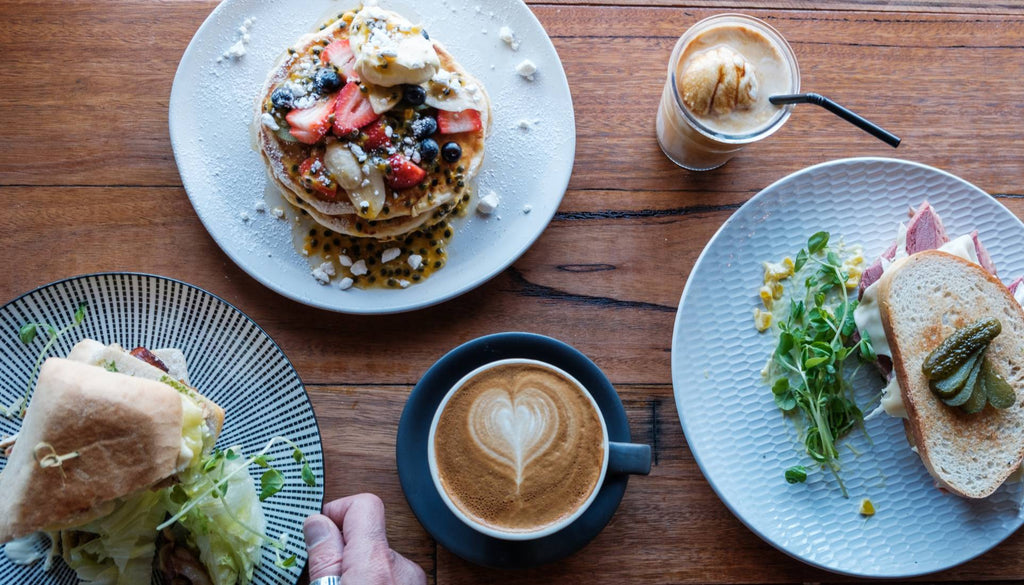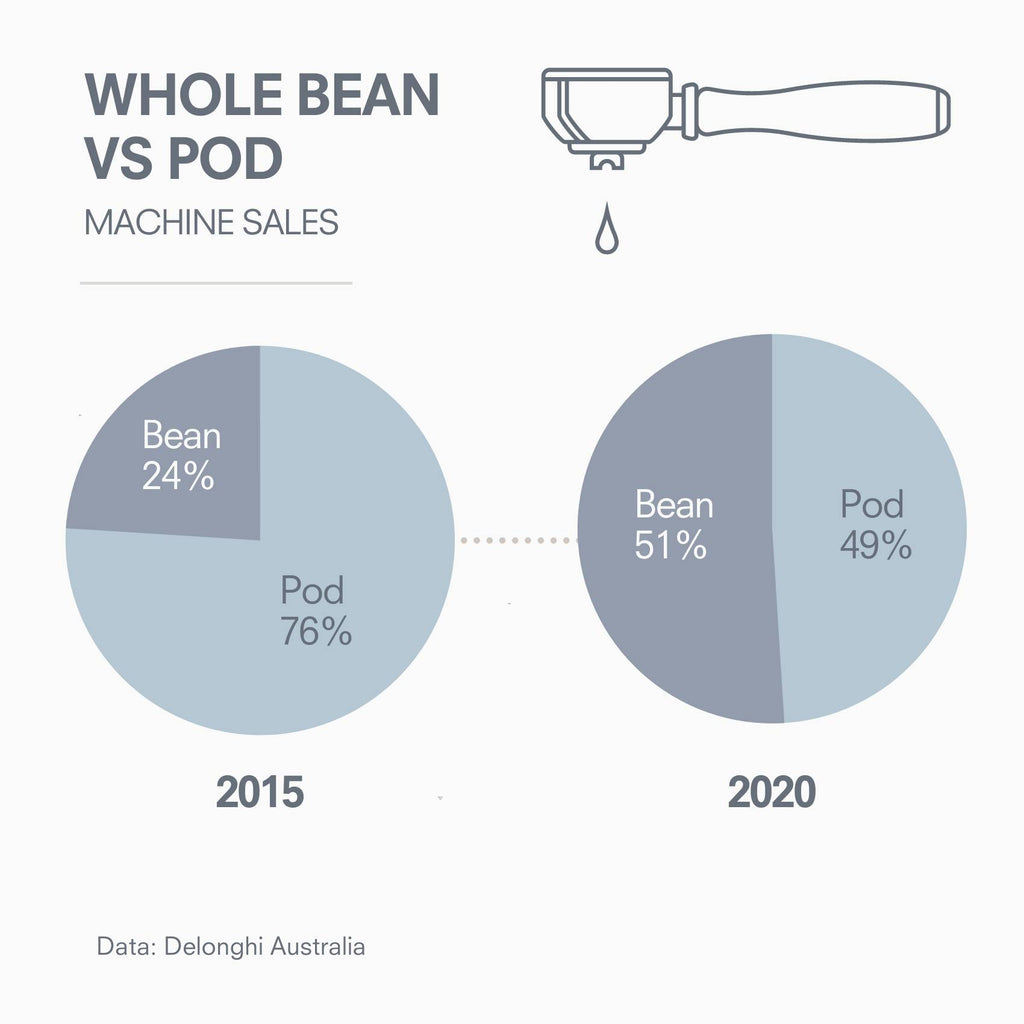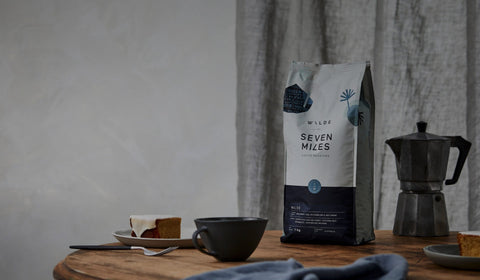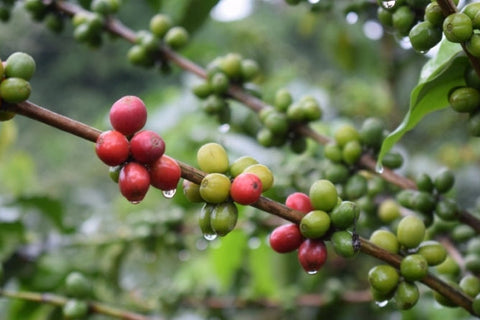For cafes, coffee shops & the coffee industry in general, the Covid pandemic has changed so many things about the way we do business. Given that it’s been over a year since we published our benchmark Cafe 2025 report, I thought it was high time to take a fresh look at the data to find out what’s changed since then, & where we think things are heading for the coffee industry.
If you missed our original report, the 3 big overall trends we observed were:
- Automation
- Craft & Cuisine
- Fast & Slow Coffee
Let’s take a closer look at what’s changed in the last 12 months.
The Rapid Rise of Automation
In our Café 2025 report, we identified automation as being a significant emerging trend in both coffee making, and in cafes at the point of sale. The last 12 months has certainly seen a significant change in both of these categories. 
Automation of Coffee Service
Automation continues to grow both in the café scene and beyond. For cafes, we have witnessed the increasing hybridization of technology. A good example of this is the improved integration of grind-by-weight grinders (such as the Mahlkonig E65S GbW), automated milk delivery systems (like the Ubermilk & Perfect Moose), and the increasing usage of automatic tamping systems. While we expect more significant changes to come, the industry continues to innovate based on the increasing demand for efficient, high quality automated systems in coffee-making. Since the end of 2020 we have also witnessed the continued expansion of self-serve coffee kiosks at Coles, 7-11 and Woolworths. These kiosks have been powered by Eversys, WMF and other automatic coffee machine manufacturers. Indeed, Eversys continues to evolve their automated offering through development of the super-traditional machine category, which may eventually see these machines operate in cafes and restaurants, or even as a part of a robotics-enabled ‘full service’ kiosk. The quality of coffee being served by these machines is improving continually, however whether out-of-home automated coffee service becomes more popular will likely depend on
- How well at-home coffee machines deliver high quality and
- How Australians respond to reduced human interaction for their drink.
As to point two, while up front it seems like there is a large barrier, McDonalds and other quick-service restaurants report significant uptake in self-ordering technologies, with many consumers preferring to deal with the accuracy and speed of machines rather than people.
Point of Sale Transformation
Mobile ordering was certainly possible pre-COVID, however we have observed significant uptake in food and coffee pickup and delivery (helped along by lockdowns).
Not only that, but in cafes and restaurants, cash payment for coffee and food has virtually disappeared.
Arguably this was going to happen naturally, but lockdowns have certainly accelerated the demise of cash payment. Another big mover is QR ordering, where customers can scan a code using their phone, order and pay at the table without any staff involvement. There are a whole lot of providers getting in on the action, including established systems like Square & also newcomers like Mr Yum, which is a QR ordering platform based in Melbourne that has grown by 27 times in the last 12 months. 
Technology keeps Evolving
And it doesn’t stop there - 2021 has seen new IOT (internet of things) telemetry systems launched in traditional espresso machines across Australia, promising consistently better coffee & remote support for small café businesses. Eversys have gone one step further by partnering with robotic service systems, offering latte art at the push of a button. In terms of adoption of these technologies, we think that various trends are going to force café owners to act sooner rather than later. Recent data indicates that there has been a sharp decline in skilled café staff (largely populated by foreign workers), brought about by restrictions on international travel. Similarly, local workers are avoiding employment in the hospitality industry due to the ever-present risk of lockdowns.
Automation has the potential to reduce the skill barrier to making excellent coffee, while simultaneously improving workplace conditions.
From what we have observed, automation has the ability to improve business efficiencies, and improve the quality of the workplace. There has never been a better time for café owners to begin to embrace new technologies. 
Convenient Craft and Cuisine
We have seen a significant change in the way that Australians consume their coffee and food, particularly out of home. For cafes, modernising their service through automation has been essential to maintain profitability. For consumers, coffee delivery and home coffee machines have been important to simply survive lockdowns.
Cafe Delivery
From the original Café 2025 report, we found that quality food offerings, combined with quality coffee are equally important to drive profitability. As such, to maintain profitability with restricted access to sit-down customers could be a disaster, if not for the improved accessibility to delivery partners - such as Uber Eats, Menulog & Deliveroo. Similarly, many operators have opted for online web-based ordering of their own invention. Many operators implemented the change to online ordering systems virtually overnight when restrictions were introduced. This signals that the café and restaurant industry is resilient and inventive.
The integration of online ordering platforms has had mixed success.
Many operators were able to increase revenue using these systems, as many saw a 30% increase in ticket sale value. So for many, online ordering has been a welcome introduction. On the other hand, the additional costs of ordering / delivery platforms has forced many café businesses to quickly adapt their pricing & profit structure to offset this sudden change. Certainly the integration of online ordering platforms will be key to making the industry resilient to lockdowns, however pricing structures need to be thoughtfully reviewed if adoption of third party software is implemented.
In-home Coffee Consumption
In terms of coffee consumption specifically, there has been a dramatic change in the amount and type of coffee consumed at home. Traditionally, the split between instant coffee & fresh coffee was around 60% Instant & 40% Fresh – however, according to Delonghi, over the last 12 months this trend has reversed. Australians are now demanding café-quality coffee at home, having been educated in our quality-focused café culture. Furthermore, consumers are putting their money where their taste buds are. Monthly sales of domestic coffee machines have increased by 300% over the last years. Of those machines, where once capsule machines outsold ‘fresh’ bean to cup machines 2:1, as of 2020, sales are at parity (i.e. 1 bean-to-cup machine sold per capsule machine sold).  Taking this data in the context of the instant:fresh coffee consumption switch; it is clear consumers are demanding fresher coffee across the board (instant to pod, pod to bean-to-cup). As such, the demand for fresh, ‘craft’/specialty coffee is increasing (similar to what we’ve observed previously). In response to these trends, the premium/specialty coffee roasters have entered mainstream supermarkets (where previously these coffees were reserved for direct sale, or through local cafes only).
Taking this data in the context of the instant:fresh coffee consumption switch; it is clear consumers are demanding fresher coffee across the board (instant to pod, pod to bean-to-cup). As such, the demand for fresh, ‘craft’/specialty coffee is increasing (similar to what we’ve observed previously). In response to these trends, the premium/specialty coffee roasters have entered mainstream supermarkets (where previously these coffees were reserved for direct sale, or through local cafes only).
As of the time of publication of this article, more than 6 well known ‘fresh roasted coffee’ brands are present in supermarkets Australia-wide. Coffee roasters are also investing more heavily in online retail sales through coffee subscriptions. In short, roasters have seen the demand for fresh craft coffee increase, and are finding new ways to deliver this to consumers. Based on these observations, consumer desire for quality and convenience is stronger than ever. And all facets of the coffee industry, from roasters to machine manufacturers, are rising to meet it.
Fast and Slow Coffee: We Want Both
We previously identified the fast and slow coffee service as being two distinct categories of growth over the next 5 years. Despite lockdowns over the last 12 months, customers still seem to be demanding both fast & slow coffee in whatever form they can get it. Certainly, when areas have gone into lockdown, fast coffee (takeaway) becomes the only option available. However, once restrictions are eased, most still wanted to enjoy coffee socially. Using data from our coffee telemetry system, We found that most coffee was consumed after 9.30am, both before & after the 2020 lockdown. In terms of consumption behaviour, this demonstrates that Australians treat their coffee as a mid-morning social break, and not only as a work-drug. This differs somewhat from international trends identified in our Café 2025 report. Based on the new data, it’s clear that coffee culture is of significant value to consumers, and indeed it’s an important part of daily routine and relationship.
There is very little difference in the proportion of coffees served before 9am on either side of the lockdown, indicating the desire for a mid-morning break for out-of-home coffee consumption. In other words, consumption habits have not change due to the pandemic or lockdowns! Another observation throughout lockdowns is how volume from inner city areas directly moves to suburban hubs. Through our coffee telemetry system, we found that while CBD coffee service decreased by 80%, residential-based cafes increase by between 10% and 35%. Clearly coffee is a near-essential part of our daily routines. More than this, it’s clear that coffee also forms an essential part of our need for society and human contact. The barista has never been so important! So, lockdowns do not kill ‘slow’ coffee – rather, they show that cafes that have a focus on both fast and slow coffee are more resilient and are well prepared for difficult times. 
Final thoughts
We have observed the implementation of many of the trends we identified a year ago rapidly accelerate. Indeed, it has been very encouraging to witness the adaptability and inventiveness of the café and restaurant industry in Australia during lockdowns. The implementation of automated technologies, both in terms of remote ordering and coffee service, kept business alive and, in some cases, improved profitability. It’s also highlighted Australian’s desire for high quality coffee, both in and out of home, with a significant increase in the purchasing of fresh ‘bean to cup’ machines. Finally, we have seen that Australians do not modify their coffee habits in response to crisis events: coffee is a source of stability and enjoyment in- and out of lockdowns. Once things get back to normal, it will be interesting to see if any of these trends reverse. We think that more people will demand coffee at-home, with premium and super-premium home espresso machines continue to grow (as discerning consumers graduate and see the value in more complex/higher quality machinery). We also think that automation in cafes will continue to grow. We don’t expect ‘fast vs. slow’ coffee to be a battle - indeed we expect the opposite - people love their coffee as much now as they did before, and nothing will change this routine.
Certainly, we have observed that the café has been, and will continue to be the place where people meet and re-energise.
So, has COVID demonstrated that Cafes are the new pub in Australia? We think so. And we hope that local communities continue to grow around their local café, and continue to evolve Australia’s world class coffee culture.













